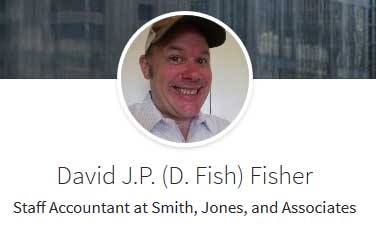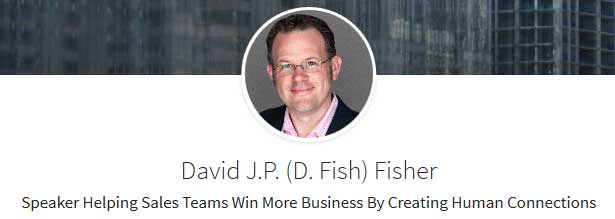- feature
- CAREER MANAGEMENT
Building a LinkedIn profile that builds your career
With just a little work, CPAs can lay the foundation for an online presence that boosts their professional persona and prospects.
Please note: This item is from our archives and was published in 2017. It is provided for historical reference. The content may be out of date and links may no longer function.

Related
As Finance Duties Shift, CAOs Take On Strategic Role
Accelerating accounting outreach, a CPA leader’s campus return
AICPA honors service and professional contributions in tax
TOPICS
Just a few short years ago, you could safely ignore your digital footprint and it wouldn’t affect your real-world interactions. Today, that’s no longer the case. Your digital presence has an effect—either positive or negative—on your career and business. Whether you are looking to attract new clients, advance in your firm, or find a new opportunity, your online presence shapes how others view you.
One of the easiest and most powerful ways you can take control of your online presence is to harness the reach and influence of your LinkedIn profile. Many online-savvy people who also are active on Facebook, Instagram, Twitter, YouTube, and other social media outlets use their LinkedIn profile as the cornerstone for their online professional brand. LinkedIn can lead the way in influencing how others engage with you in your online and offline interactions. This article shows how to use LinkedIn to move your career forward.
3 STRATEGIC QUESTIONS MAKE ALL THE DIFFERENCE
The omnipresence of digital information has flipped the traditional process of how we establish business relationships. In the past, we would extend provisional trust to someone and then build a working relationship to bolster that trust. Now, we can research and investigate someone before we ever engage. In fact, we can decide whether we even want to start a professional conversation based on what we find.
That’s why it’s important to control the brand messages that you are sending online. A great place to start is with LinkedIn, which has a huge footprint with more than 400 million members. If you do a Google search on yourself, there’s a good chance that your LinkedIn profile will be one of the top results. If you have an unfinished or sloppy LinkedIn profile, that’s not the first impression you want to make with someone who could be a client, a colleague, or an employer. Luckily, a little time and attention can take your LinkedIn profile from lackluster to outstanding (see the sidebar “Examples of Good and Bad LinkedIn Profiles”).
At the root of every ineffective LinkedIn profile and wasted status update is a lack of planning. It’s important to know what you are trying to say before you look at the ways that you can say it. Asking and answering a few simple strategic questions can greatly improve how effective, efficient, and easy-to-use your LinkedIn profile is.
What are your most important business goals?
Though your career or business goals may seem obvious to you, it’s important to articulate them with specificity. This process can be as simple as saying, “I want to develop stronger relationships with the leaders in my firm to get on a partner track in the next 12 months.” If you are trying to get new clients, you could say, “I want to increase my pipeline of business owners so that I can close five additional deals this quarter.”
Who is the most important audience for you to communicate with?
Many different people will view your profile. If you try to speak to all of them at the same time, your message will become muddled. Identify the most useful group to engage with, and focus your profile and content on these people. For example, if you want to bring in new clients, speak directly to the target market that you serve: business owners, families, etc. Or if your business goals require you to be seen as an expert, engage with centers of influence or decision-makers at other firms.
What message does that audience need to hear?
Once you know exactly who is in your target audience, consider what they need to hear from you. The best communicators don’t focus on what they want to say but on the information their audience needs or wants to receive. This is the core of your personal brand. Understanding how you want to be perceived is a critical step toward sharing effectively on LinkedIn. Imagine that you are talking to your profile visitor offline. What would you highlight? Would you focus on your experience, your passion for your work, or your unique ability to solve their problems? That’s what your profile should focus on.
HOW TO CRAFT AN OPTIMIZED LINKEDIN PROFILE
Once you’ve decided what message you want to share, and whom you want to share it with, the next step is to dive into crafting your profile. It can be overwhelming to look at the different sections and fields on the profile. Fortunately, you can focus on a few sections that do a lot of the heavy lifting to communicate your brand.
The LinkedIn headline
Found right underneath your name, the LinkedIn headline is up to 120 characters long and fulfills some incredibly important functions. Eye-tracking studies show that people spend more time on average reading the headline than on any other part of the profile. The headline, like those in a newspaper, is the key to grabbing readers’ attention and then convincing them to read more on the page.
Instead of leaving your headline as the default (your job title), you can use keywords to draw in readers. Refer to whom you help and how you help them. What’s more powerful: CPA at Firm X, Y, and Z or Public Accountant Helping Businesses Manage Complex Tax Issues? A simple template is filling in the blanks: “Helping (insert whom you help) with (what you help them with).”
Profile photo
If a picture is worth a thousand words, what are the thousand words of your profile photo saying about you? More and more of our online interaction is becoming visually based, and how you present yourself is a key component of your online presence. People like to see whom they are interacting with.
LinkedIn has reported that a profile with a photo gets up to 14 times more views than a profile without a photo. It’s hard to define the “perfect” photo because it can be subjective and depend on a lot of variables. But here are three easy elements to keep in mind:
- Keep your profile photo consistent with the rest of the information you are sharing. Ask yourself, “Is the person in the photo the same person that the visitor is reading about?” If you talk about how hard you work for your customers, but your photo is of you lounging on a beach, there’s a mismatch.
- Make sure it’s a polished photo. Both you and the photo itself need to have a certain degree of professional polish. You don’t need an uptight headshot, but you have to convey that others can trust your competence. Low-grade or inappropriate photos don’t do that.
- Balance that polish with approachability. Humanize yourself. Does the person in your photo look like someone with whom others would feel comfortable interacting? (See “Examples of Bad and Good LinkedIn Headers” below)
Examples of bad and good LinkedIn headers
Bad header

Good header

Profile summary
The profile summary is a chance to speak directly to your visitor. It’s like having an elevator speech that’s available 24 hours a day. The ideal profile template has three short paragraphs of just two to three sentences each—short, sweet, and simple. Let’s take a look.
- First things first: Tell people what you do on a day–to–day basis. Don’t use internal jargon or fall back on your job title. For example, your reader might not know what a partner or client executive does at your organization. You have to explain what you do and whom you help. This could be as basic as saying, “I’m an independent CPA who specializes in working with not-for-profits to perform annual audits” or “As a partner at our firm, I work directly with our business clients to minimize their tax liabilities.” It’s a short version of your elevator speech. If you were at a neighborhood barbecue and someone asked you what you do, what would you say? That’s how you start your summary.
- Tell the reader what makes you better than the competition. You need to differentiate yourself. Usually, this is going to include an “I” statement about you and a “we” statement about your firm or employer (if applicable). There’s a reason you are good at what you do and people like to work with you. It might be your experience, competence, skill sets, passion, or something else. Whatever it is, share it. It could be as simple as saying, “I have 20 years of experience in the field, so I know how to solve our customers’ challenges.” You could share your passion: “I love when I’m able to help our employees shine.” Also, think of the one or two sentences that you would use in describing the best parts of your firm or company. That’s what you would add here.
- Finally, share something about yourself. People want to connect with other people online, not companies or brands. Be a human and recognize that your personal and professional spheres are intertwined online. You don’t have to say you’re a Virgo who likes long walks on the beach and fine dining. Rather, share one nonprofessional activity and one detail about it.For example, don’t say that you “like to spend time with your kids,” because that tells people only that you are a normal human being. However, if you say you like to spend time with your kids and you coach their Little League team, that’s more informative. If you like to bake, tell your reader about your most popular creation. If you are a golfer, let people know what course you are dreaming of playing. You can give a little “hook” that creates a natural starting point for a conversation.
Current and previous experience
Your LinkedIn profile isn’t your résumé. If you just cut and paste a bunch of bullet points, you’ll bore your audience at best and drive them away at worst. Instead, think of it as an extension of your summary. Here, you can share the narrative of your career arc. Don’t list your past jobs just to fill in the blanks but instead to show how you got where you are today. Include a two-to-three-sentence description of what you did in previous roles and what experience you took from them that you apply in your current work.
Other areas of the LinkedIn profile
You can share more information via the many other areas of the LinkedIn profile—from the Certifications and Education sections to the Volunteer Experience and Organizations listings. You don’t have to include this information, but ask yourself if doing so would share a fuller picture of you to your reader. If the answer is yes, add the information. If the answer is no, you can skip these sections and be just fine.
BUILDING YOUR ONLINE NETWORK
Developing an optimized profile is a great first step, but you can unlock a host of opportunities by actively using the site. Before you do that, though, you’ll want to build your connections on LinkedIn. Here are a few guidelines about who should be in your network:
- Always remember that this is your network. Who you are or are not connected to is always your choice.
- Research shows that most of the opportunities in any network come from weak connections—people we know but don’t have regular contact with. You might not see a reason to be connected with an old colleague or college friend now, but that could change in the future.
- If someone you don’t know asks to connect, see if you share an industry, location, or connection before you ignore it. You might not know that person now, but you might want to later.
- You can choose to disconnect from people in your network at any time. Just visit the connections page and remove them. They won’t get a notification; they’ll just be removed from your network.
- Balance reach and trust. Just because you can connect to everyone doesn’t necessarily mean you should. You still have to earn the right to engage with people—a privilege that’s especially important in a time of very short attention spans.
ENGAGE WITH YOUR CONNECTIONS
Building your profile and network is only part of the process; the next step is to engage with your connections. This can take many forms, depending on your role, your personality, and how you want to spend your time.
LinkedIn offers two easy ways to pursue your goals.
Use LinkedIn to listen. Most professionals think that social media platforms are for sharing. That’s true, but it’s easy to forget that we can start by listening to everything that others are sharing. Scanning the LinkedIn newsfeed for five to 10 minutes a day can provide a wealth of business intelligence. People in your network will share their opportunities, challenges, and victories. You will be well-positioned to congratulate them on what is going well and offer your help on the obstacles that they face.
After you listen, you can use LinkedIn to share with your network. The goal isn’t to grab everyone’s attention with every post. Rather, it’s to have an ongoing stream of content coming from you. That way, when something triggers a connection’s interest, he or she can reach out and engage. Even two to three posts a week can be very effective (see the sidebar “5 Easy Ways to Share With Your Network”).
The overarching objective is to extend the reach of your personal brand message from your profile. An easy way to think of personal branding is that it’s the convergence of reputation and visibility. Reputation is what people think of you, i.e., what you are sharing on your profile. Visibility is making sure that they think of you in the first place. You can share client successes or current projects, professional conferences and trainings you’ve attended, or articles you have written or ones you have read and found interesting. By sharing this content online, you let your network know what you are focused on professionally. This in turn keeps you on their radar and makes you the natural choice when they need help.
THE NEXT STAGE IN BUSINESS RELATIONSHIPS
Online conversations aren’t going to replace real-world interactions anytime soon. But used correctly, digital communication does provide a host of opportunities to improve and strengthen our offline relationships. Our online presence and communications precede us into our offline conversations and can help make those conversations more effective and efficient. A polished presence on LinkedIn is the first step to leveraging the power of the web to bolster your career and your business. See you online!
Examples of good and bad LinkedIn profiles
Bad profile
John Doe
Headline: Accountant at Smith Accounting.
Summary: CPA with major accounting firm. 14+ years of experience working with clients on tax preparation, financial audits, and other accounting services.
Good profile
John Q. Public
Headline: Helping businesses maximize cash flow and long-term growth through effective accounting systems.
Summary: In my role as a senior accountant at Smith Accounting, I focus on helping small business owners with their accounting world. I work with them on their year-end and ongoing tax preparation needs. But that’s just the beginning. I also see my role as being an adviser who helps them understand how taxes, revenues, and expenses can be managed for business success.
5 easy ways to share with your network
- Post a picture from a professional event that you are attending, such as a conference or industry meeting.
- Announce a service that your firm offers that people might not know about.
- Remind everyone about an important deadline or general accounting tip.
- Forward an article from an industry publication with information your connections would find useful.
- Once in a while, share a personal success or story, e.g., achieving a new certification or celebrating a personal milestone.
About the author
David J.P. Fisher is a sales expert, professional keynote speaker, and best-selling author. You can reach him via his LinkedIn profile at linkedin.com/in/iamdfish.
To comment on this article or to suggest an idea for another article, contact Jeff Drew, senior editor, at Jeff.Drew@aicpa-cima.com or 919-402-4056.
AICPA resources
Articles
- “8 Tips for Finding, Hiring, and Retaining the Best Busy Season Staff,” CPA Insider, Jan. 17, 2017
- “How New CPAs Can Build a Book of Business,” JofA, Dec. 2016
- “4 Ways to Write a LinkedIn Profile That Attracts Recruiters’ Attention,” FM, Nov. 17, 2016
Publications
- CPA Client Bulletin Select (#PCN1301W, download)
- Take Your Marketing Online! Proven Ways to Grow Your Firm in the Digital Age (#PPM1501P, paperback; #PPM1501E, ebook)
CPE self-study
- MBAexpress: Success With Social Media (#BLIMBA27, online access; #GT-MBASWSM, group training)
For more information or to make a purchase, go to aicpastore.com or call the Institute at 888-777-7077.
Online resources
Private Companies Practice Section and Succession Planning Resource Center
The Private Companies Practice Section (PCPS) is a voluntary firm membership section for CPAs that provides member firms with targeted practice management tools and resources, including the Succession Planning Resource Center, as well as a strong, collective voice within the CPA profession. Visit the PCPS Firm Practice Center at aicpa.org/PCPS. The Succession Planning Resource Center, which includes a succession planning guide, podcasts, survey results, and a Succession Readiness Assessment and Timing Calculator is available at aicpa.org/pcps/succession.



















